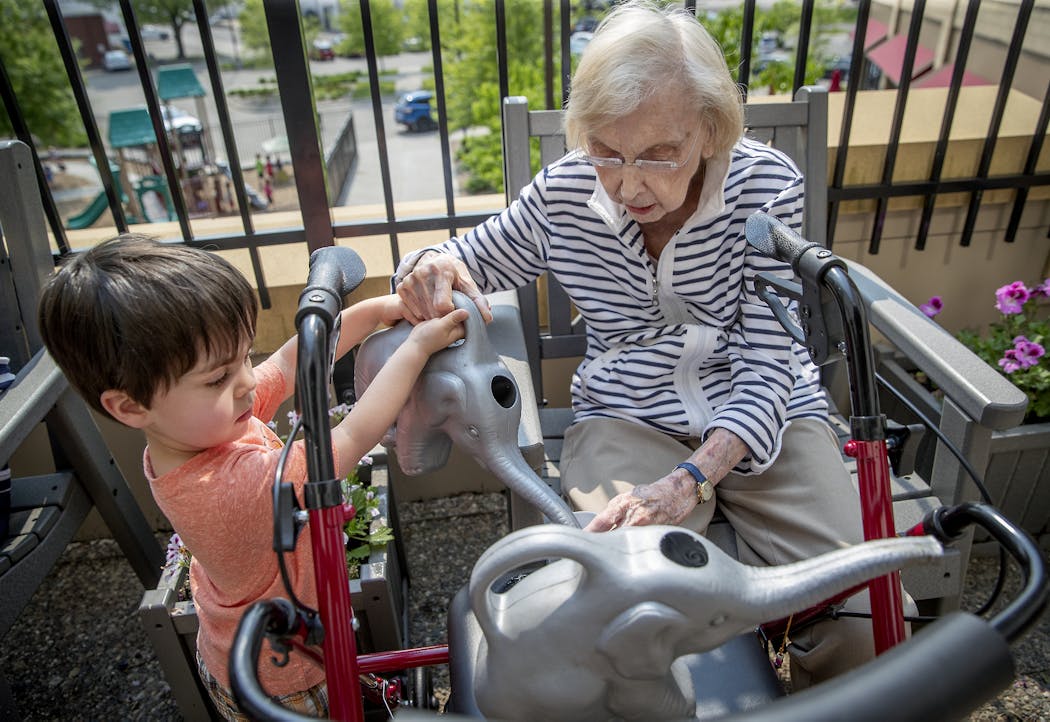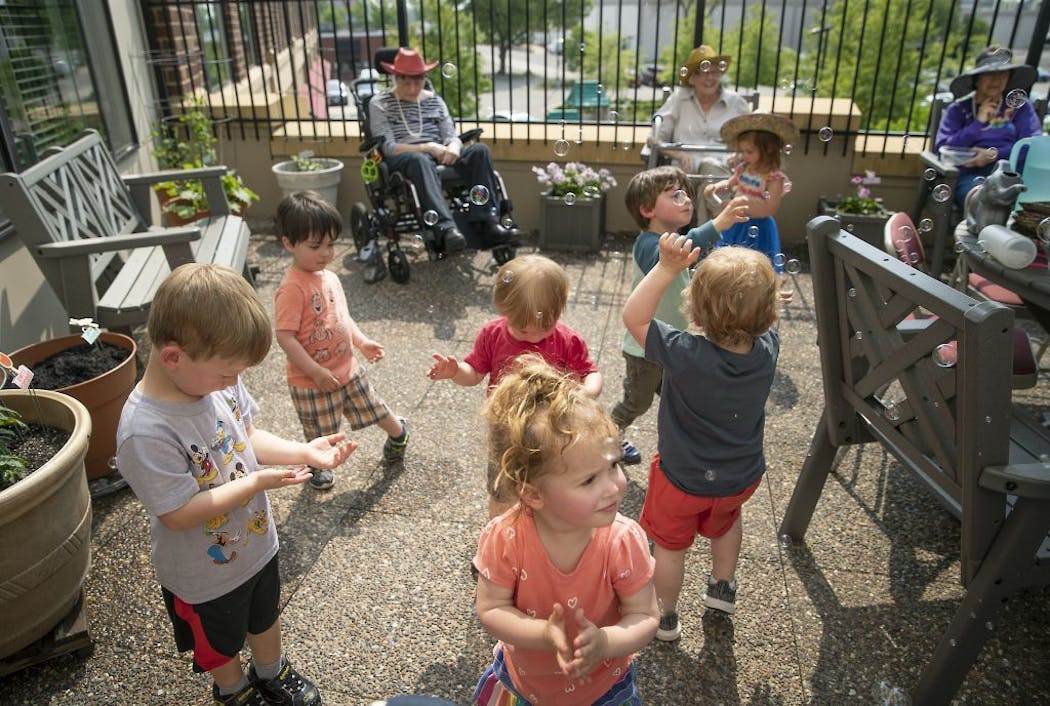Two-year-old Logan Clifford's brown eyes lit up to see the little gray watering can shaped like an elephant that was balanced on Evelyn Larson's walker.
"There you go!" said Larson with a smile, as the toddler carefully lifted the container and started sprinkling water on the pink geraniums near her feet.
"Don't spill on your grandfriends!" cautioned Angela Truitt, who runs the intergenerational program at TowerLight in St. Louis Park where Logan attends day care and where Larson lives in the memory care unit.
Because the buildings are next door to each other and part of the same facility, these sweet interactions between young children and their elderly "grandfriends" happen all the time at TowerLight, during planned activities like that day's gardening session or in everyday moments.
The little ones who wake up early from their naps often visit the seniors to "read" the newspaper, said Michelle Jirik, director of child care at TowerLight, while folks in independent living will stop by the infant room to rock some of the littlest babies to sleep.
"These children end up wondering where their grandfriends are when they go off to kindergarten. Every year I receive that phone call from a parent," Jirik said.
TowerLight, which began its intergenerational program in 2013, is one of several sites in the Twin Cities area bringing little kids and older adults together for care. Mount Olivet Day Services in Minneapolis also offers child care and adult day services in a shared site, while the Intergenerational Learning Center in Eagan includes programming with senior living residents next door.
Ebenezer Ridges in Burnsville, which, like TowerLight, is run by Fairview Health Services, started offering these kinds of services under the same roof 17 years ago. While there are many challenges, the concept is growing in Minnesota. Fairview is set to open three new intergenerational programs — one in Chanhassen this fall, one in Prospect Park in 2020 and one in Bloomington the following year, said Ann Schrempp, the intergenerational director at Ridges.
Schrempp, who sent her son to preschool at Ridges, feels that it "sent him off to kindergarten unafraid of age and disability."
That kind of feedback is common, said Donna Butts, the executive director of Generations United, a national nonprofit that works to bring generations together and studies intergenerational programs.
"Children who have been in intergenerational care, every administrator I've talked with has said, when our kids go into public school, or regular classrooms, we hear from those schools and principals that they are the best behaved, they are the most accepting of children with differences, they are more patient, more empathetic," she said.
"It's those soft skills, those human skills. Having that extra attention and having older adults who aren't afraid to correct their English or cuddle them and tell them they love them. It's just incredibly beneficial for the children."
For older adults, the constant connection to little kids can provide a real sense of purpose, she said.
"They rise to meet the expectations of the other. The children behave better, and the older adults are more on, and with it. It challenges them to be the best they can be," she said. "They are waiting eagerly for the children to arrive, and then they just light up."
The programs are so popular among the families who take part, Butts said, that many often ask — why aren't there more of them out there?
There are at least 110 shared sites nationwide where care for kids under age 5 is paired with programs that serve older adults, Generations United found in a 2018 survey conducted with Ohio State University. In another poll, the nonprofit found that the public is largely unaware these kinds of places even exist — one reason it's so difficult to replicate successful programs or start new ones.
Navigating the many regulations that govern how day cares and nursing homes operate is often challenging, Butts said. Securing funding for both types of care instead of just one or the other can also be difficult.
"What happens often times, is that everybody loves the idea. But we've made it so complex and difficult with our policies, our zoning regulations, our accreditation, our standards, that it's really difficult for someone to come in and do," she said.
For a program to be successful, it's important to train staff properly and plan the right kinds of interactive programming, Butts added. For example, the little kids shouldn't just come in and put on a music show.
"While there's all kinds of magic that happens when you put generations together, it takes planning," she said.
The magic was certainly evident during a recent music program for both preschoolers and seniors at Ridges, put on by visiting teachers from MacPhail Center for Music who play guitar and piano.
The adults all sat, some in chairs, some in wheelchairs, in a large circle around the room. As the preschoolers filed in excitedly, a few sought out a special grandfriend's eye.
For one little girl named Sutton, that special grandfriend is a man named James. When her teacher encouraged the little kids to find a partner and dance, she gleefully ran up to him, and gently clasped his hands to move to the music. They "danced" like this to tunes like "Jailhouse Rock" and "Ants Go Marching," playing peek-a-boo and laughing.
When it was time to leave, she ran back and planted a kiss on his hand.
"She's a sweet little thing," her grandfriend said.
Movie Review: A lyrical portrait of childhood in Cabrini-Green with 'We Grown Now'
Judge declines to dismiss lawsuits filed against rapper Travis Scott over deadly Astroworld concert

Summer Movie Guide: Virtually all the movies coming to theaters and streaming from May to Labor Day



